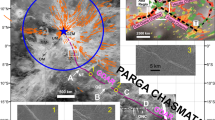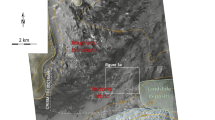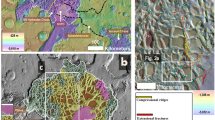Abstract
Groundwater is a crucial reservoir in Mars’s global water cycle1,2 and plays an important role in aqueous alteration of bedrock3,4,5,6. Understanding groundwater flow is also important for assessing the possibility of past and present martian life7. The Valles Marineris is a series of fault-bounded troughs and chasms stretching over 4,000 km from west to east, with a width of 600 km and depth of up to 10 km below the surrounding high plains8. In this region, ancient groundwater movement is suggested by links between chasms of the Valles Marineris and the sources of catastrophic floods in chaotic collapse terrains9. Here, images obtained by the Viking, Mars Express, Mars Reconnaissance Orbiter and Mars Odyssey missions are used to map ridges on the walls of the Valles Marineris that extend in an east–west direction up to the surface of the surrounding high plains from almost 7 km beneath10. These erosion-resistant ridges, which can be tens of kilometres long, most likely represent cementation of the fault zones and surrounding rock by water-deposited minerals11,12 and suggest that groundwater in this region flowed for long distances through major east–west-trending fault systems. This interpretation implies that liquid water was stable at (or near) Mars’s surface when the fault zones were cemented ∼3,500–1,800 Myr ago and that chemical deposition from groundwater was regionally significant.
This is a preview of subscription content, access via your institution
Access options
Subscribe to this journal
Receive 12 print issues and online access
$259.00 per year
only $21.58 per issue
Buy this article
- Purchase on Springer Link
- Instant access to full article PDF
Prices may be subject to local taxes which are calculated during checkout




Similar content being viewed by others
References
Clifford, S. M. A model for the hydrologic and climatic behavior of water on Mars. J. Geophys. Res. 98, 10973–11016 (1993).
Carr, M. H. & Head, J. W. III. Oceans on Mars: An assessment of the observational evidence and possible fate. J. Geophys. Res. 108, 5042 (2003).
Bibring, J. P. et al. Global mineralogical and aqueous Mars history derived from OMEGA/Mars express data. Science 312, 400–404 (2006).
Squyres, S. W. & Knoll, A. H. Sedimentary rocks at Meridiani Planum: Origin, diagenesis, and implications for life on Mars. Earth Planet. Sci. Lett. 240, 1–10 (2005).
Ming, D. W. et al. Geochemical and mineralogical indicators for aqueous processes in the Columbia Hills of Gusev crater, Mars. J. Geophys. Res. 111, E02S12 (2006).
Bridges, J. C. et al. in Chronology and Evolution of Mars (eds Kallenback, R., Geiss, J. & Hartmann, W.) 365–392 (ISSI Space Science Series, Vol. 96, Kluwer, Amsterdam, 2001).
Beaty, D. et al. Findings of the Mars special regions science analysis group. Astrobiology 6, 677–732 (2006).
Luchitta, B. K. et al. Mars 453–492 (Univ. Arizona Press, Tucson, 1982).
Palmero-Rodriguez, J. A., Sasaki, S. & Miyamoto, H. Nature and hydrological relevance of the Shalbatana complex underground cavernous system. Geophys. Res. Lett. 30, 1304 (2003).
Treiman, A. H. & Spiker, K. Fault-continuation ridges in the Valles Marineris, Mars: Evidence for groundwater circulation. Lunar Planet. Sci. XXVII, 1339–1340 (1996).
Okubo, C. H. & McEwen, A. Fracture-controlled paleo-fluid flow in Candor Chasma, Mars. Science 315, 983–985 (2007).
Davatzes, A. & Gulick, V. Evidence for tectonically controlled hydrothermal fluid flow in relay zones on Mars from early HiRISE images. Lunar Planet. Sci. XXXVIII, Abstract no. 1788 (2007).
Anderson, R. C. et al. Primary centers and secondary concentrations of tectonic activity through time in the western hemisphere of Mars. J. Geophys. Res. 106, 20563–20586 (2001).
US Geological Survey Topographic Map of the Ophir and Central Candor Chasmata Region of Mars (MTM 500k–5/287E OMKT). USGS Geologic Investigations Series I-2807 (2003).
US Geological Survey Topographic Map of the West Candor Chasma Region of Mars (MTM 500k–05/282E OMKT). USGS Geologic Investigations Series I-2805 (2004).
Wilson, L. & Head, J. W. III. Tharsis-radial graben systems as the surface manifestation of plume-related dike intrusion complexes. J. Geophys. Res. 107, 5057 (2002).
Davis, P. & Golombek, M. Discontinuities in the shallow Martian crust at Lunae, Syria, and Sinai Plana. J. Geophys. Res. 95, 14231–14248 (1990).
Schultz, R. A., Moore, J. M., Grofils, E. B., Tanaka, K. L. & Mège, D. The Geology of Mars: Evidence from Earth-based Analogs 371–399 (Cambridge Univ. Press, New York, 2007).
Mozley, P. & Goodwin, L. Patterns of cementation along a Cenozoic normal fault: A record of paleoflow orientations. Geology 23, 539–543 (1995).
Ormö, J., Komatsu, G., Chan, M. A., Beitler, B. & Parry, W. T. Geological features indicative of processes related to the hematite formation in Meridiani Planum and Aram Chaos, Mars: A comparison with diagenetic hematite deposits in southern Utah, USA. Icarus 171, 295–316 (2004).
Gendrin, A. et al. Sulfates in martian layered terrains: The OMEGA/Mars Express view. Science 307, 1587–1591 (2005).
Squyres, S. W. & the Athena Science Team.Recent results from the Mars exploration rovers. Bull. Amer. Astron Soc., Division Planetary Sciences AAS Conf. abstract 14.01 (2007).
Coleman, N. M. Large-scale permeability in the upper crust of Mars estimated from Earth analogs. EOS Trans. AGU, 81, Fall Meet. Suppl., Abstract P62C-11 (2000).
Tanaka, K. L. & Chapman, M. G. The relation of catastrophic flooding of Mangala Valles, Mars, to faulting of Memnonia Fossae and Tharsis volcanism. J. Geophys. Res. 95, 14315–14323 (1990).
Tanaka, K. L. & Chapman, M. G. Kasei Valles, Mars: Interpretation of canyon materials and flood sources. Proc. Lunar Planet. Sci. 22, 73–83 (1992).
Tanaka, K. L. & Golombek, M. P. Martian tension fractures and the formation of graben and collapse features at Valles Marineris. Proc. Lunar Planet. Sci. Conf. 19, 383–396 (1989).
Barnett, D. N. & Nimmo, F. Strength of faults on Mars from MOLA topography. Icarus 157, 34–42 (2002).
Acknowledgements
This work began as an LPI Summer Internship in 1995 with K. Morgan (nee Spiker), now of the Colorado Geological Survey. Technical support from B. Fessler was invaluable, and P. McGovern assisted with presentation of graphics. Image access is courtesy of NASA, ESA and individual instrument teams (Viking, HRSC, MOC, THEMIS and MRO CTX). Critical reviews by C. Okubo and J. Clarke strengthened the manuscript. Supported by the NASA Astrobiology Institute node at NASA Ames Research Center (D. Desmarais, P.I.). Lunar and Planetary Institute Contribution 1389.
Author information
Authors and Affiliations
Corresponding author
Supplementary information
Supplementary Information
Supplementary figures S1-6 (PDF 568 kb)
Rights and permissions
About this article
Cite this article
Treiman, A. Ancient groundwater flow in the Valles Marineris on Mars inferred from fault trace ridges. Nature Geosci 1, 181–183 (2008). https://doi.org/10.1038/ngeo131
Received:
Accepted:
Published:
Issue Date:
DOI: https://doi.org/10.1038/ngeo131
This article is cited by
-
An Analysis of Morphology and Diverse Mineralogy in Ius Chasma, Valles Marineris Using MCC, CRISM and CTX Data
Journal of the Indian Society of Remote Sensing (2022)
-
A deep groundwater origin for recurring slope lineae on Mars
Nature Geoscience (2019)
-
Remote Sensing for Martian Studies: Inferences from Syrtis Major
Journal of the Indian Society of Remote Sensing (2018)
-
Groundwater flow as a cooling agent of the continental lithosphere
Nature Geoscience (2016)
-
A glimpse of martian plumbing
Nature Geoscience (2008)



